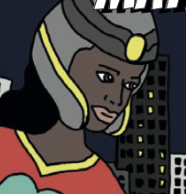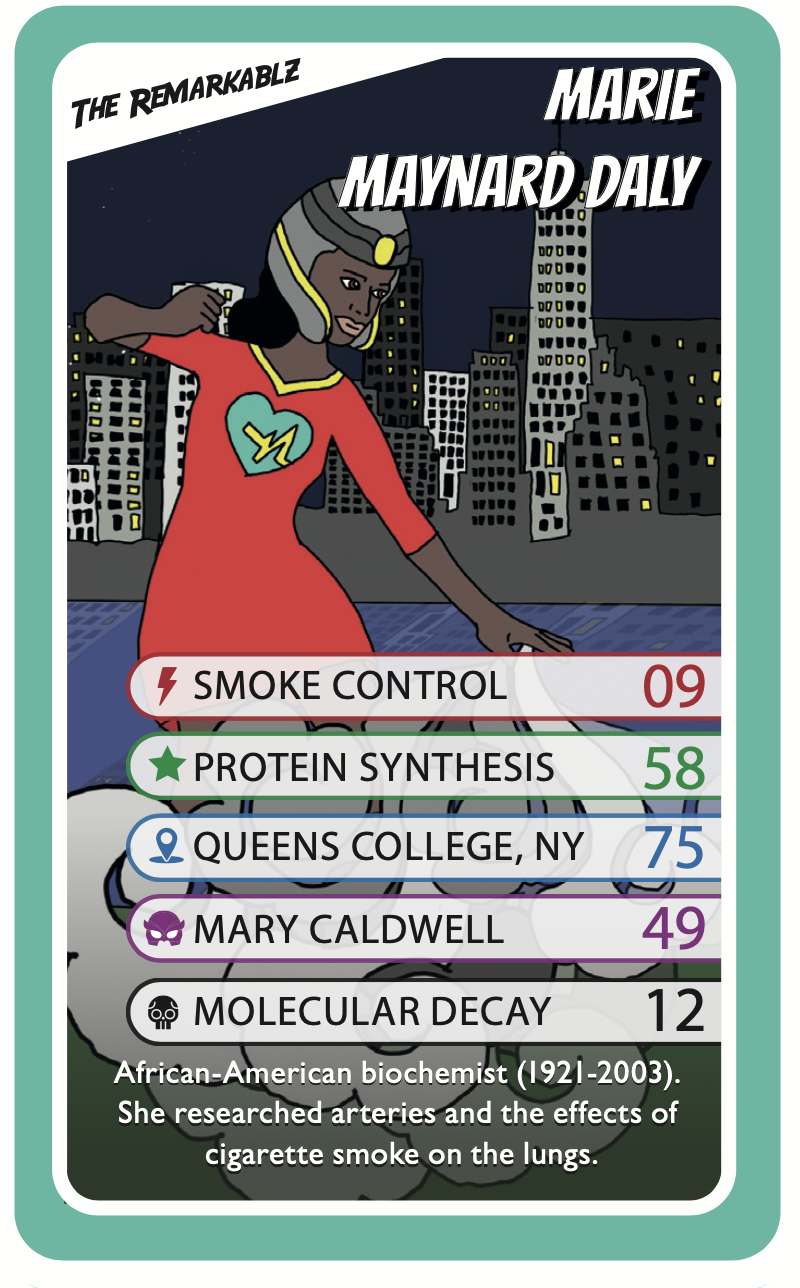
Get to Know
Marie Maynard Daly
Discover why we turned Marie into a superhero
WHO WAS MARIE MAYNARD DALY?
Full name: Marie Maynard Daly
Born: 1921
Died: 2003
Occupation: Chemist
Nationality: American
Marie was born and raised in New York City, She loved reading and one of her favourite books as a child was The Microbe Hunters.
Marie was awarded her doctoral degree in 1947 and was the first African American woman to obtain a PhD in chemistry in the United States. She conducted important studies on cholesterol, sugars, and proteins. Her research showed the relationship between high cholesterol and clogged arteries. She understood how smoking and the foods we eat can affect the health of our hearts.
Born: 1921
Died: 2003
Occupation: Chemist
Nationality: American
Marie was born and raised in New York City, She loved reading and one of her favourite books as a child was The Microbe Hunters.
Marie was awarded her doctoral degree in 1947 and was the first African American woman to obtain a PhD in chemistry in the United States. She conducted important studies on cholesterol, sugars, and proteins. Her research showed the relationship between high cholesterol and clogged arteries. She understood how smoking and the foods we eat can affect the health of our hearts.

In The Remarkablz Universe... The Smoke Weaver. Marie was experimenting with a rare molecular compound found in cigarette smoke, when an unexpected chemical reaction enveloped her in a swirling cloud of dense vapor. She inhaled—then everything went still. When she awoke, she found she could summon and control smoke at will. With a single breath, she could sap energy from even the fiercest villain, leaving them dazed and harmless.
Superhero Backstory
Marie features in our signature card game, Top Quarkz. The game supports the development of maths, literacy and decision-making skills all while learning about some of the most impressive scientific discoveries throughout history.
We've explained the drawing and her playing card below so you can learn more
We've explained the drawing and her playing card below so you can learn more
Marie has the power to create and manipulate smoke causing lethargy in her opponents
- The background of this drawing is New York City. Marie was born in the Corona neighbourhood of Queens, New York.
Superpower
Marie researched protein synthesis. This is the process in which cells make proteins.
In 1942, Marie graduated from Queens College with a bachelor's degree in chemistry.
Location
SideKick
Mary Caldwell helped Daly discover how chemicals produced in the body contribute to food digestion.
If molecular decay sets in, particles break down too fast, making her smoke lose its structure and potency.
Weakness
Each drawing we create has one or more hidden treasure(s) about our superheroes' life experiences, depictions in art, jobs or discoveries. Did you find the ones hidden in this drawing?
Discovery

We have packed a lot into our Top Quarkz playing cards - from amazing imagined superpowers to biographical information and hidden treasures.
EDUCATIONAL RESOURCES
Find out more about Marie
Marie studied how our diets and habits, like eating fatty foods or smoking, could lead to heart disease. She helped uncover how cholesterol builds up in arteries, a key factor in heart health. Her work helped form the foundation for what we know today about cardiovascular disease, nutrition, and wellness.
Video credit: Hertford College, Oxford
Video credit: Hertford College, Oxford
What Do Chemists Do?
People who work in chemistry are called chemists. Chemists study the substances that make up matter. They also study the changes that take place when substances are combined. These changes are called chemical reactions.
Video credit: Binogi
Video credit: Binogi
A Day In The Life of A Chemist
Check out this video about a day in the work life of a chemist. Follow Hilary Corkran's and find out where science and chemistry can take you.
Video credit: careersnz
Video credit: careersnz
What is Hypertension?
What is Hypertension? This great little video will explain Hypertension and High Blood Pressure.
Video Credit: DrSmarty
Video Credit: DrSmarty
Smoking affects your heart!
Watch this short video from the British Heart Foundation and find out why smoking can put you at risk of getting heart and circulatory diseases.
Video Credit: British Heart Foundation
Video Credit: British Heart Foundation
What is Cholesterol?
Did you know that there are two types of cholesterol: Good cholesterol and bad cholesterol. Learn more in this video!
Video Credit: WebMD
Video Credit: WebMD
How to Make a Working Heart Pump Model for Kids (Using a Jar, Balloon, and Straw)
Step 1: Create your blood.
Fill your jar just over halfway with water. Add a few drops of food colouring to represent blood.
Step 2: Make the heart wall.
Cut off the neck of the balloon and stretch the balloon tightly over the mouth of the jar. This balloon represents the muscular wall of the heart that contracts to push blood out.
Step 3: Add the heart valves.
Use scissors to carefully poke two small holes in the balloon—just big enough to insert straws tightly.
Step 4: Build your one-way valve.
Take the cut balloon neck and slide it over the end of one straw. Tape it securely. This acts as your valve—it should stop water from flowing back in.
Step 5: Insert both straws into the holes.
Make sure the straw with the valve is tightly sealed. The other straw should be left open.
Step 6: Watch the heart in action.
Press down on the balloon to simulate the heart squeezing (contracting). You’ll see the coloured water being pumped out through the open straw. This mimics how the heart pumps blood into arteries.
Fill your jar just over halfway with water. Add a few drops of food colouring to represent blood.
Step 2: Make the heart wall.
Cut off the neck of the balloon and stretch the balloon tightly over the mouth of the jar. This balloon represents the muscular wall of the heart that contracts to push blood out.
Step 3: Add the heart valves.
Use scissors to carefully poke two small holes in the balloon—just big enough to insert straws tightly.
Step 4: Build your one-way valve.
Take the cut balloon neck and slide it over the end of one straw. Tape it securely. This acts as your valve—it should stop water from flowing back in.
Step 5: Insert both straws into the holes.
Make sure the straw with the valve is tightly sealed. The other straw should be left open.
Step 6: Watch the heart in action.
Press down on the balloon to simulate the heart squeezing (contracting). You’ll see the coloured water being pumped out through the open straw. This mimics how the heart pumps blood into arteries.
What you will need
- 1 jar (glass or plastic)
- 1 balloon
- 2 drinking straws
- Scissors
- Clear tape
- Food colouring
- Water
What's Happening?

Looking for a fun and educational science experiment to teach kids how the heart works? This simple activity demonstrates how a human heart pumps blood using chambers and valves. Perfect for classrooms, homeschooling, or science fair projects!
Step-by-Step Instructions
When you press the balloon, it forces water (your “blood”) out of the jar—just like the heart contracts to push blood out. The balloon valve on one straw prevents water from coming back in, just like real heart valves do. If you remove the valve, water flows back in, showing what happens when heart valves don’t work properly.
Sign up to our Newsletter
By signing up to receive emails, you agree that we may use the personal information provided by you to send you marketing emails. You can opt out of these emails any time by clicking the unsubscribe link or by contacting us. To see how we use your personal data, please see our Privacy policy.
